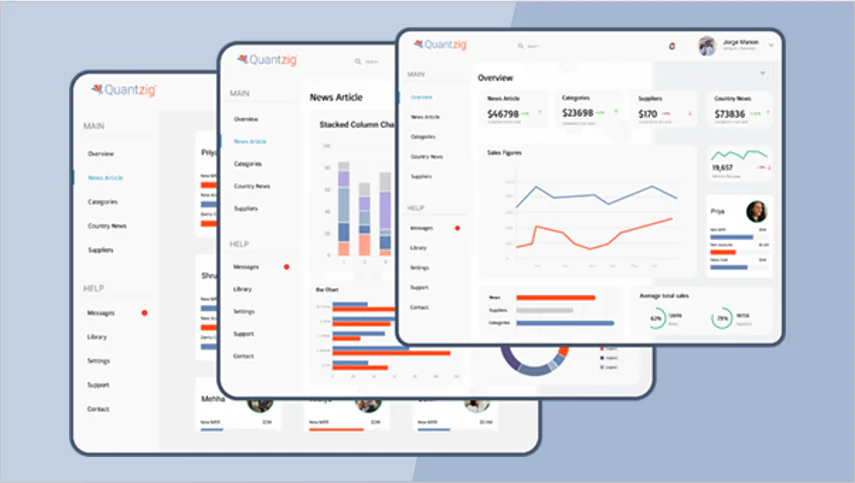In the rapidly evolving Consumer-Packaged Goods (CPG) sector, accurately predicting consumer demand has become more challenging than ever. Traditional demand planning methods no longer suffice in today’s volatile market. Demand sensing in CPG is the game-changing solution, utilizing real-time data, advanced analytics, and machine learning to predict and respond to consumer shifts with remarkable precision. This article delves into how demand sensing transforms supply chain management, reduces costs, and enhances consumer satisfaction.
Demand sensing in CPG enables companies to forecast demand more accurately, adapt to market fluctuations, and optimize their inventory management. By harnessing the power of real-time data, businesses can remain agile, making informed decisions that drive operational efficiency and market responsiveness. This approach offers CPG companies the competitive advantage needed to meet ever-changing consumer demands while improving profitability and supply chain performance.
Book a demo to experience the meaningful insights we derive from data through our analytical tools and platform capabilities.
Request a Demo
Table of Contents
What is Demand Sensing in CPG?
Demand sensing in CPG is a dynamic approach to demand forecasting that leverages real-time data analytics, machine learning, and predictive algorithms to anticipate market shifts and consumer behavior. Unlike traditional demand planning systems, which are largely based on historical data, demand sensing continuously monitors and analyzes current trends and external factors. This allows businesses to detect demand signals in real-time and adjust their operations accordingly, ensuring a more accurate and responsive supply chain.
By using advanced data science techniques, demand sensing empowers companies to better understand consumer preferences, optimize inventory levels, and reduce stockouts. The goal is to improve forecast accuracy, minimize operational costs, and ensure that products are available at the right time and place, ultimately enhancing customer satisfaction.
Importance
Demand sensing has become critical for Consumer-Packaged Goods (CPG) companies that face constant market volatility, shifting consumer preferences, and complex supply chain dynamics. In today’s digital age, real-time data is essential for staying competitive, as traditional forecasting methods are too slow and reactive to keep up with rapid market changes. Demand sensing technologies allow businesses to predict demand fluctuations ahead of time, adapting their strategies for supply chain operations and inventory management with precision.
The importance of demand sensing lies in its ability to enhance supply chain visibility, reduce waste, and improve decision-making in real-time. For CPG companies, this means being able to respond quickly to changes in consumer behavior, global events, or shifts in market demand. As consumer expectations continue to evolve, demand sensing becomes crucial to maintaining operational efficiency and a competitive edge.
Advantages
- Real-Time Data Utilization
Demand sensing leverages real-time data, allowing businesses to adjust forecasts and strategies instantly. This enables CPG companies to respond more quickly to market fluctuations, reducing delays and missed sales opportunities. - Improved Forecast Accuracy
By using predictive analytics and machine learning, demand sensing significantly enhances forecast accuracy. This helps companies reduce the risks associated with stockouts or overstocking, ensuring a more reliable supply chain. - Enhanced Inventory Management
With demand sensing, businesses can maintain optimal inventory levels. This reduces excess inventory costs, improves warehouse efficiency, and ensures that products are available when consumers need them. - Cost Efficiency
By minimizing stockouts, overproduction, and other inefficiencies, demand sensing reduces operational costs. CPG companies can allocate resources more effectively, improving profitability and overall supply chain performance. - Proactive Decision Making
Demand sensing enables companies to anticipate shifts in demand, allowing them to take proactive actions. This foresight helps avoid last-minute adjustments and ensures that companies are always prepared for changes in consumer preferences.
Disadvantages
- Data Quality Challenges
Demand sensing relies heavily on high-quality, real-time data. Inconsistent or inaccurate data sources, such as consumer conversations or social media posts, can lead to flawed predictions, undermining the effectiveness of the system. - Integration Complexities
Implementing demand sensing technologies may require significant integration with existing systems and infrastructure. Companies may face challenges in aligning new technologies with their legacy systems, leading to potential disruptions during the transition. - High Initial Investment
While demand sensing offers long-term benefits, the initial investment in technology, data infrastructure, and training can be substantial. Smaller companies may find it difficult to justify the upfront costs, even though the returns are significant over time. - Dependence on Technology
Heavy reliance on advanced technology and algorithms may cause issues if the systems fail or experience glitches. A malfunctioning demand sensing system can disrupt the entire supply chain, causing delays and errors in demand forecasts. - Change Management Resistance
Adopting demand sensing requires a cultural shift within organizations, particularly when transitioning from traditional demand planning methods. Resistance to change from employees or leadership can delay or hinder the successful implementation of the system.
Request a no-obligation pilot to experience the benefits of demand sensing in CPG. Tailored to your needs, this pilot will demonstrate how our solutions can optimize your supply chain and forecasting accuracy. Get started today!
Start your trial nowStrategies
- Leverage Machine Learning for Continuous Adaptation
Machine learning algorithms help demand sensing systems continuously improve by learning from new data inputs. Companies should prioritize this adaptability to ensure their systems remain relevant as consumer behavior evolves. - Integrate Real-Time Data Sources
To maximize the benefits of demand sensing, CPG companies must integrate real-time data from multiple sources such as social media, online shopping trends, and weather patterns. This provides a comprehensive view of shifting demand signals. - Focus on Predictive Analytics
Investing in predictive analytics tools will allow businesses to forecast demand shifts more accurately. By anticipating future trends, companies can adjust their strategies proactively, avoiding disruptions and maintaining customer satisfaction. - Optimize Inventory with Dynamic Replenishment
Demand sensing should be coupled with dynamic replenishment strategies. By adjusting inventory levels in real-time based on demand forecasts, businesses can ensure they are always in line with market needs, avoiding stockouts or overstocking. - Adopt a Scalable Solution
Implementing a scalable demand sensing solution enables businesses to expand as needed, adjusting to growing markets or fluctuating demands. This flexibility ensures that the system can accommodate future growth without significant operational disruptions.
Applications
Demand sensing in CPG has seen increased application across various sectors, with businesses leveraging real-time data and predictive analytics to streamline supply chains and improve forecasting accuracy. In the food and beverage industry, demand sensing helps companies adapt to sudden changes in consumer preferences, ensuring that products are always available on store shelves when needed. By anticipating shifts in demand, businesses can better manage seasonal fluctuations and marketing campaigns.
In the consumer electronics sector, demand sensing plays a vital role in adjusting inventory based on product launches or promotional activities. This agility allows companies to minimize excess inventory while maximizing sales during peak demand periods. As e-commerce continues to grow, demand sensing systems are increasingly important for managing the complex, omnichannel distribution models that characterize the modern retail environment.
Additionally, beauty and personal care brands are adopting demand sensing to optimize their product launches and better align with fast-changing consumer trends. With real-time insights into demand fluctuations, these companies can improve production planning, minimize supply chain inefficiencies, and enhance customer satisfaction.
What the Future Holds?
As demand sensing technology continues to evolve, the future will see even more integration of AI and machine learning to enhance forecasting accuracy. These advancements will further optimize inventory management, enabling CPG companies to fine-tune their supply chains and reduce costs. Real-time analytics will also play a pivotal role in the adoption of autonomous systems, where AI-driven decision-making powers supply chain operations without human intervention, ensuring greater efficiency.
The future will also see the widespread integration of demand sensing with other digital transformation initiatives. Technologies such as blockchain for secure data sharing and IoT for real-time tracking will enhance demand sensing capabilities. As consumer behaviors and supply chains become even more complex, the need for agile, data-driven decision-making will be paramount, making demand sensing a critical tool for navigating the future of CPG.



